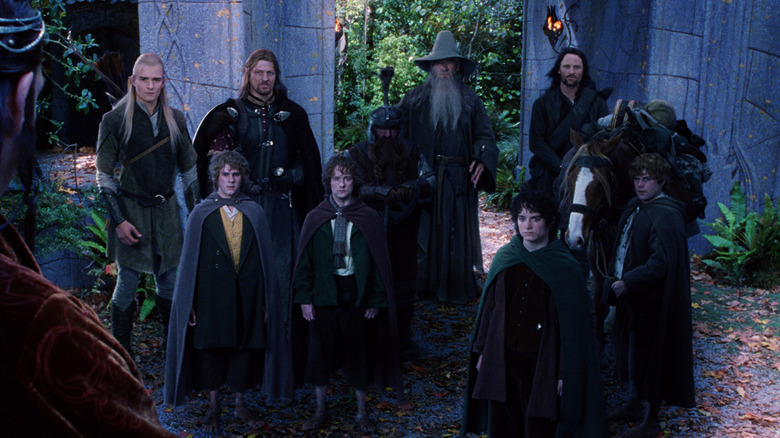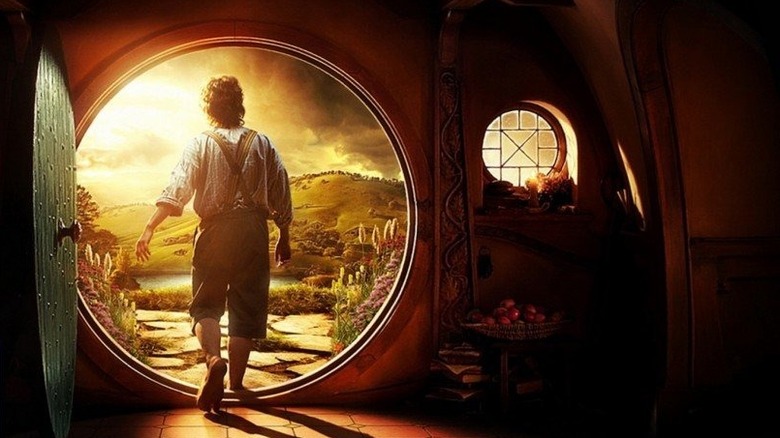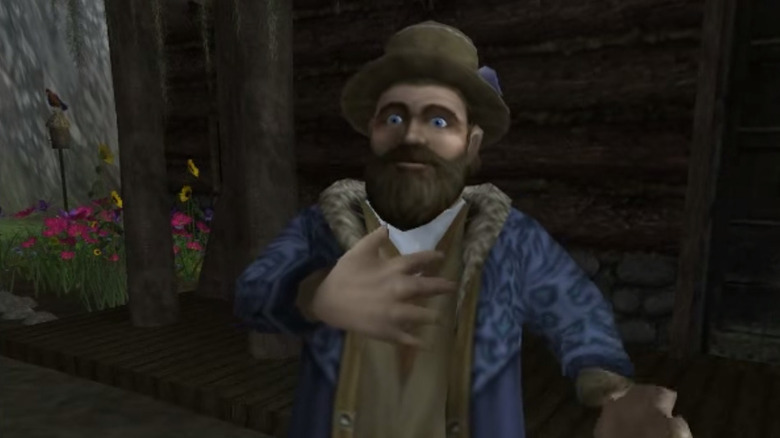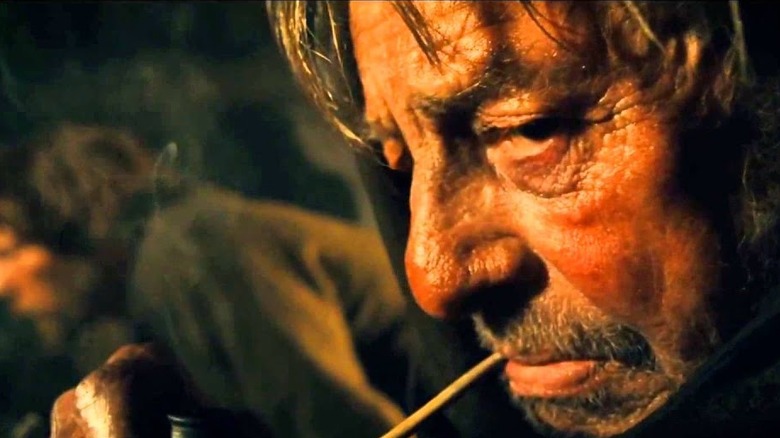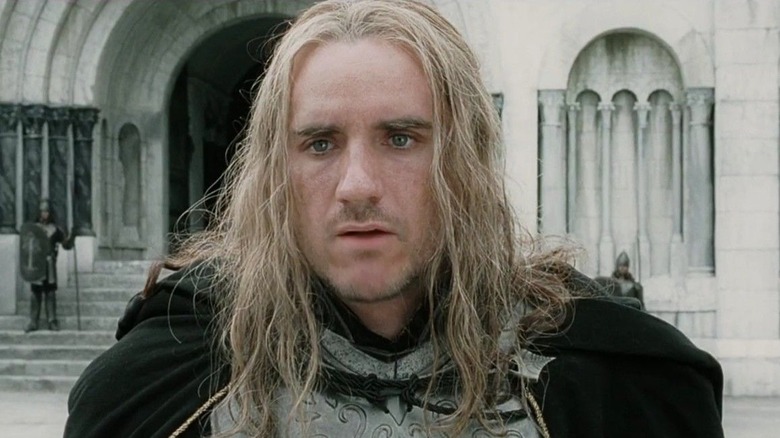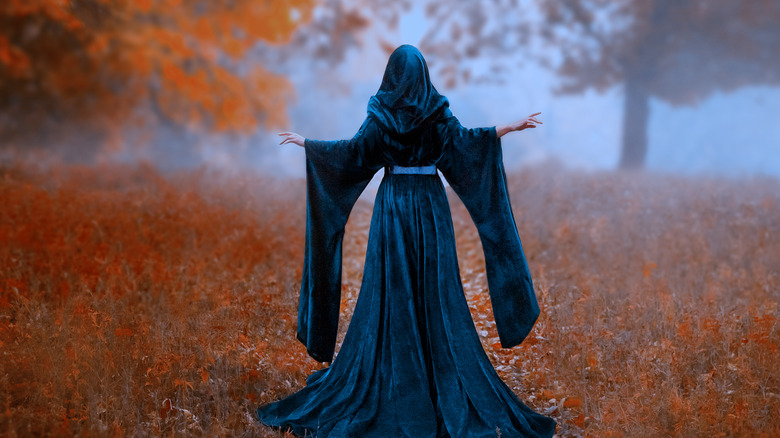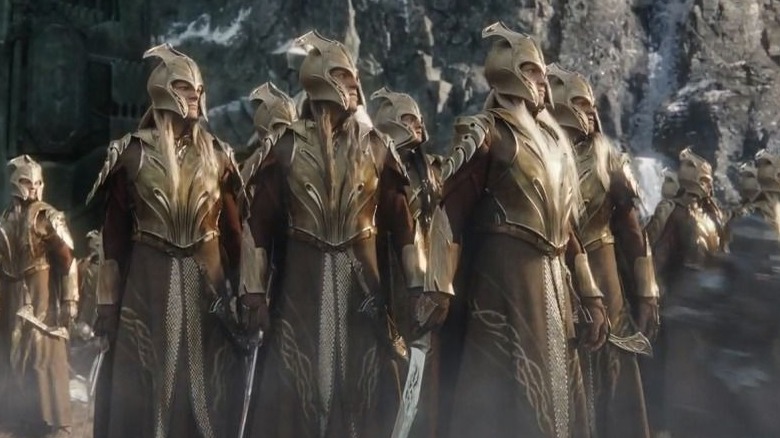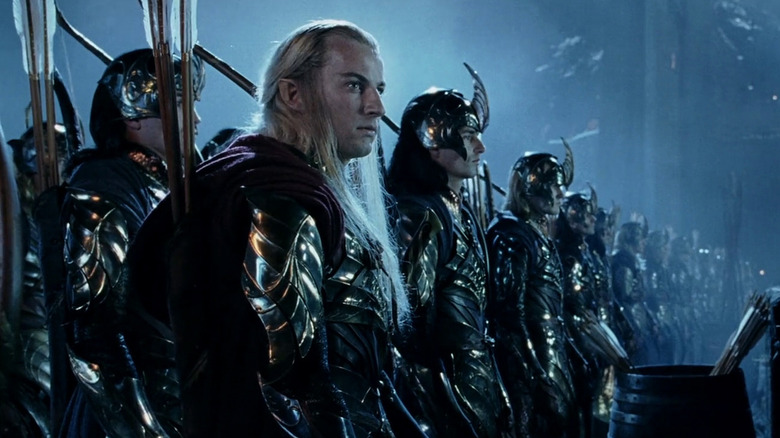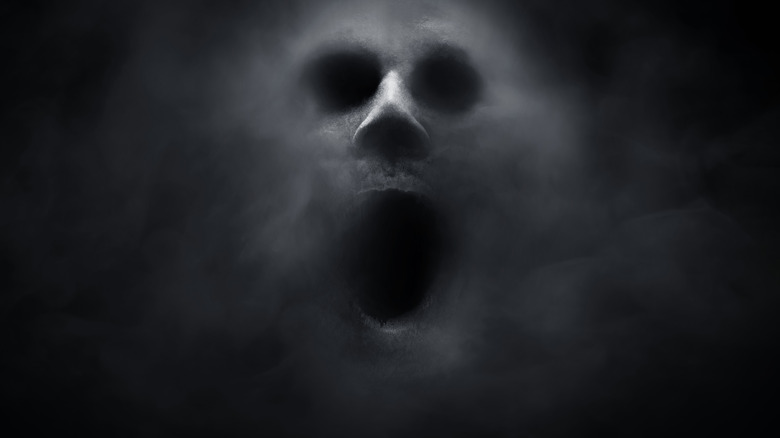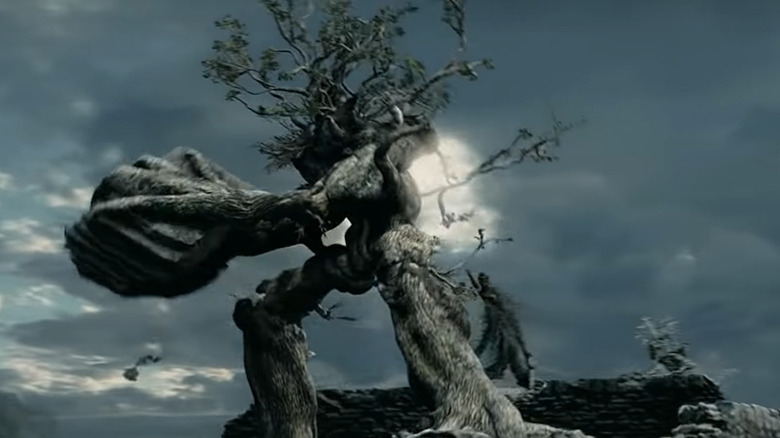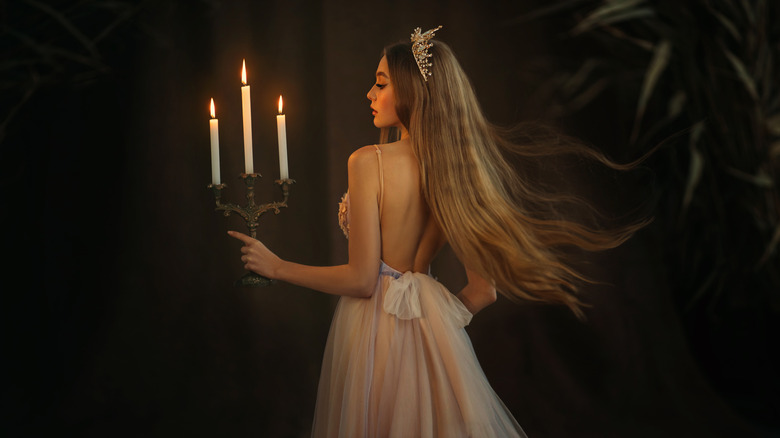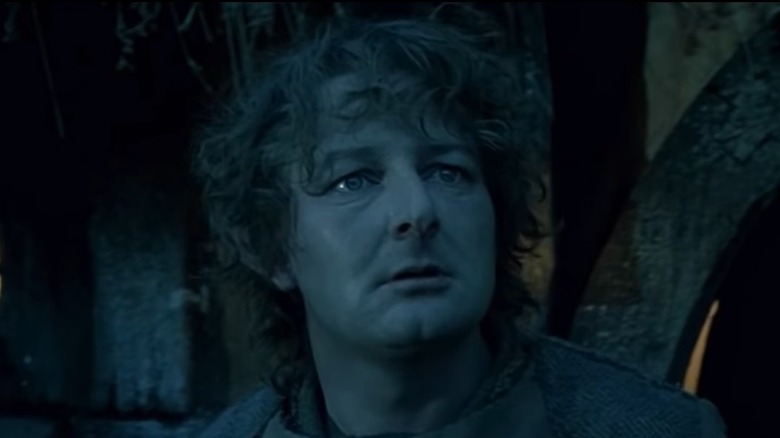The Best Lord Of The Rings Characters Who Weren't In The Movies
Peter Jackson's "The Lord of the Rings" trilogy is one of the greatest in film history, both a box office blockbuster and a runaway awards-season success. Indeed, "Lord of the Rings: The Return of the King" wasn't just the first fantasy film to win best picture at the Academy Awards — it also tied the all-time record for most wins (with 11), an honor shared only by "Ben-Hur" and "Titanic."
Back when the project was initially announced, however, Jackson might have seemed an unusual choice to helm the series. He was best known for his inventive early horror films, including "Bad Taste," "Dead Alive," "Meet the Feebles," and "The Frighteners," and a prestige project felt like a strange pick for his next endeavor. However, Jackson was a loyal follower of Tolkien's work, and dedicated years to crafting a trilogy that would honor the author's meticulous worldbuilding.
While Jackson's films are very long (even longer in their Extended Editions), they were still missing many details from the novels. The material of "Lord of the Rings" was so dense that the feature film versions simply didn't have room for every creature, event, and character. Here are some of the best "Lord of the Rings" characters who didn't make the cut.
Fatty Bolger
One of the things that makes "Lord of the Rings: The Fellowship of the Ring" such a great first chapter is the time dedicated to showing viewers The Shire. What a perfect way to introduce the differences between each of the four Hobbits! Frodo Baggins (Elijah Wood) is curious and open-minded, yet completely innocent and unexposed to the dangers of the world. Samwise Gamgee (Sean Astin) is unquestionably loyal to his best friend Frodo, but lacks confidence and fears traveling outside of the comforting environment. Merry (Dominic Monaghan) and Pippin (Billy Boyd) are rambunctious troublemakers who only seem to get the gang into trouble.
The ample screen time depicting Hobbit culture and the lead-up to Gandalf's arrival allows the viewer to understand why these innocent characters are unlikely heroes on their quest, and seeing The Shire come under threat following Gollum's escape is devastating. While many of the other Hobbits get screen time during Bilbo's birthday party, not all of the Hobbits mentioned in the novel appear onscreen. Fredegar Bolger, also known as "Fatty," is mentioned as a childhood friend of Frodo's who learns of his secret quest to Rivendell from Gandalf.
Fatty Bolger helps Frodo, Sam, Merry, and Pippin in their escape, but does not join them once they leave The Shire. He stays behind with the knowledge of the One Ring's existence, and eventually comes under threat when Saruman orders his forces to take The Shire captive in "Return of the King."
Tom Bombadil
"The Fellowship of the Ring" is relentlessly paced, but the novel took a bit more time depicting the Hobbits' journey from their home in The Shire to their fateful encounter with Aragorn (Viggo Mortensen) at the Prancing Pony. In the book, the four young heroes have an even more challenging journey to meet the Ranger, as they're faced with the woodland dangers and mysterious creatures of the forest. The appearance of Tom Bombadil is one of their most memorable encounters, and he is perhaps the most prominent character within "The Lord of the Rings" absent from the films.
Tolkien imagined Bombadil as a mysterious traveler whose adventures spanned all Four Ages of Middle-earth's history. He lives in the Old Forest east of The Shire, has a constantly changing personality (a trait that makes him one of the novel's more interesting characters), sings goofy songs that confuse the Hobbits, and possesses a vast knowledge of the world from his adventures in the First and Second Ages. Frodo and friends discuss the One Ring with Tom, who suggests wearing it to turn invisible. He even briefly takes the powerful item from Frodo as a joke before returning it. Tom is a prominent enough figure that he even earns a mention from Elrond once the Hobbits are united with the Elves.
Tolkien continued telling Tom's adventures with the 1962 poetry book "The Adventures of Tom Bombadil," which collects 16 poems centering on side characters from the original trilogy. Also worth noting: Bombadil did make it into one "Lord Of The Rings" adaptation, back in 1991.
Bill Ferny
The Hobbits' first encounter with Aragorn, at first only known to them as the enigmatic Ranger "Strider," is an intense sequence in which The Hobbits adjust to the dangers of their mission. Their recent encounter with Sauron's Nazgul forces has left them shell-shocked, and they're initially skeptical of trusting Strider. Although the future king eventually grows an affinity for the earnest young Hobbits, their relationship is strained in the beginning. Strider trusts Gandalf's judgment in assigning the quest to Frodo, but he's annoyed by the misbehavior of Merry and Pippin.
The Hobbits' tense first meeting with Aragorn in Bree exposes them to even more dangers in the book. Saruman has installed the secret agent Bill Ferny, a man of Bree, to the Prancing Pony location, and the scheming spy provides details about the Hobbits' location to the dark wizard. He reveals secrets to the Nazgul that force the Hobbits to make a hasty getaway with Strider, but — despite his loyalties to the forces of evil — Bill is ultimately selfish. He tries to broker a deal with Strider to earn extra cash by selling ponies. Ironically, the pony that Strider adopts becomes Sam's trusted companion throughout his adventure, and accompanies him all the way to their final destination of Moria.
Bill shows up again in Tolkien's "Return of the King" to aid in Saruman's takeover of The Shire. Thankfully, the Hobbits get their revenge and the pony turns on its former owner.
Imrahil
It must've been difficult topping the jaw-dropping Battle of Helm's Deep that concluded "The Two Towers," but with The Battle of Gondor, Jackson assembled one of the largest and most stunning open-field combat scenes in cinematic history. Each of the characters gets their individual moments of heroism. The competition over most Orcs slain between Gimli (John Rhys-Davies) and Legolas (Orlando Bloom) provides comic banter, but the standout moment is undoubtedly the heroism of King Theoden's daughter, Eowyn (Miranda Otto). Eowyn carries Merry with her in battle and squares off against the Nazgul leader.
This amazing scene was populated with even more characters in the book. In Tolkien's novels, Prince Imrahil plays a prominent role in the conflict and comes to Aragorn's aid. He gives Aragorn critical advice about entering Gondor, noting that Denethor is untrustworthy and that, in a state of grief, the leader has slipped into madness. In the aftermath of the battle, Imrahil is installed as a temporary leader in Gondor as Faramir heals from his wounds. He later joins Aragorn in the Battle of Black Gate, and fights on the frontlines until Mount Doom is destroyed.
The Prince of Dol Amroth, Imrahil is the uncle of Boromir (Sean Bean) and Faramir (David Wenham). He has four children, and his youngest daughter Lothiriel ends up marrying Eomer (Karl Urban) once he takes his uncle's place as King.
The Blue Wizards Pallando and Alatar
The White Council is among the most influential forces in all of Middle-earth. Gandalf naturally seeks the Council's guidance once he learns of Sauron's return, and Saruman (Christopher Lee) is seen as among the wisest in the order. Saruman's alliance with Sauron comes as a shock, and his rivalry with Gandalf provides an engaging conflict throughout the trilogy. However, outside of these two prominent characters, no other wizards are depicted in the initial trilogy. The woodland-dwelling Radagast the Brown appears in "The Hobbit" trilogy as an ally to Gandalf, but some of the other wizards are absent.
Blue wizards Pallando and Alatar are the other members of the five-part Council that reign over Middle-earth. Not much is known about their exploits during the second War of the Ring, but both were integral in the Second Age, back when Sauron first emerged, and were tasked with ensuring that the other forces of men were not recruited by Sauron. Sauron had grown to become a mythic figure to some of the Eastern kingdoms, and many tribes of men had joined his alliance of evil.
It would've been interesting to see what Jackson could have done with these characters, as Tolkien provides very few specific details about their personalities. The reinvention of Radagast in "The Hobbit" was not what some fans expected, but the more comedic depiction made that trilogy more entertaining.
Glorfindel
The Elves play a prominent role in "The Lord of the Rings" trilogy, and across all three films there's a real diversity present in how they're portrayed. Elrond (Hugo Weaving) is among the wisest characters in all of Middle-earth, but he's deeply skeptical of the plight of men to endure. He fears the marriage of his daughter Arwen (Liv Tyler) to Aragorn, as he knows that her immortality will lead to eventual heartbreak upon Aragorn's death. However, Legolas is much more open to alliances with other species, and forms a tight personal bond with Gimli. "The Hobbit" trilogy introduced even more major Elven characters when Bilbo and his allies entered the Woodland territory.
The political dynasty of the Elves is quite complex in Tolkien's novels, and some of the integral characters were clearly left out of the film adaptation for the sake of pacing. Glorfindel is among the most fascinating, as he was the lord of Gondolin's House of the Golden Flower during the ancient First Age of Middle-earth, but was killed in combat during a conflict with the Orcs. Thanks to the magic of Valar, Glorfindel was able to return to his physical form and join Elrond's fight against Sauron in the War for the Ring.
It was actually Glorfindel who finds himself tasked with rescuing Frodo after he is critically wounded by the Nazgul, but in Jackson's version that role is fulfilled by Arwen. It was, perhaps, a necessary change to elevate her character.
Elladan and Elrohir
The relationship between Elrond and Arwen is among the richest in all of the "Lord of the Rings" trilogy. Elrond's ancient history within Middle-earth has given him an informed opinion about its future, yet his skepticism gives him a slightly cynical edge. Arwen struggles to court her father's insights as she considers a life with Aragorn, and their frank discussions about her prospects for the future are quite emotional. However, this family dynamic is even more complex in the books thanks to the appearances by Elrond's two sons, Elladan and Elrohir.
While not technically twins, Elladan and Elrohir have a strong personal bond and are rarely apart from each other. Compared to the more cynical nature of their father, Elladan and Elrohir are very open to working with men, and they formed many personal relationships as they aided the Rangers of the North in the years prior to the War for the Ring. When Sauron's return is revealed and the Council of Elrond is gathered, the pair are assigned to scout out a path for Frodo to keep the Elven elders informed about the Orcs' troop movements. Rarely silent about their opinions, the two take part in the Council discussions and support Gandalf's plans of an all-out assault on Sauron's forces. They returned to play a prominent role in "Return of the King," joining Aragorn's combined army at the Battle of Black Gate. It's unfortunate these two fun characters were left out.
The Barrow-Wight
Although some were skeptical that a more horror-themed filmmaker like Jackson could honor the complexity of Tolkien's mythology, the filmmaker's history with practical gore and creature effects turned out to be quite beneficial when bringing "The Lord of The Rings" to the big screen. There's a spooky design to creatures like the Nazgul and Uruk-hai that renders them genuinely frightening, with "Fellowship of the Ring" being the scariest of the series. While "The Two Towers" and "Return of the King" were more epic in scope and focused on the political dynamics between various kingdoms, the first film follows the titular band of heroes as they travel through enigmatic territories and encounter horrifying natural threats.
In Tolkien's book, the journey for the Hobbits to reach Rivendell is even scarier. The Hobbits are already in a vulnerable state. They have yet to find Aragorn's assistance, and Gandalf has left to seek out Saruman, leaving them with no wise older figure to offer them guidance in their adventure. The Barrow-Wights, shape-shifting malicious figures that roam the Old Forest, are one of the many threats they face along the way. The ghostly creatures capture the Hobbits, and Frodo is nearly killed after he attempts to engage them in combat.
Thankfully, the Hobbits are rescued by their new ally Tom Bombadil, who performs an exorcism in order to shield them from the Barrow-Wight threat. It's fun to imagine what someone like Jackson might have done with this sequence.
Quickbeam
The appearance by the Ents is one of the more compelling elements of "The Two Towers." Previously, Merry and Pippin had been depicted as comic characters, yet they have more prominence once they're separated from the rest of the Fellowship. The goofy pair manage to escape the Uruk-hai and venture into the forest alone, and initially Treebeard is a comforting presence who offers them protection. However, Merry grows impatient with Treebeard's slow decision-making process and demands that the Ents do something about the rising threat of Saruman. The Council of the Ents is eventually spurred into action by Saruman's destruction of sacred land, and they help lead an attack on Isengard.
Treebeard is the only Ent that gets prominent screen time in the films, but in Tolkien's novel, a number of others are also developed. While still ancient, the Ent Bregaland (known by his common name "Quickbeam") is among the youngest and sharpest of his species. He quickly sides with Merry's assertion that Saruman must be dealt with, and is horrified to discover his fellow Rowan trees slain by the Orc forces. Quickbeam bonds with Merry and Pippin as they await the Council's decision.
During the attack on Isengard, Quickbeam is the first to lead the charge. Seeking vengeance for his fallen friends, Quickbeam nearly manages to subdue Saruman himself before the evil wizard escapes justice. While "The Two Towers" already has a packed conclusion, seeing more action from the Ents could have been truly awe-inspiring.
Goldberry
"Lord of the Rings" is a nearly perfect trilogy, but there are criticisms to be made. For instance: While Eowyn, Galadriel, and Arwen have more expanded roles than they do in the novel, there's a significant lack of strong female heroes within the series. Jackson was bound by his loyalty to Tolkien's original source material, to be sure, but one of the author's more interesting female characters was nowhere to be found.
Goldberry's omission isn't surprising, as she is the wife of Tom Bombadil, who also remained offscreen. The mysterious "river-daughter" resides in the Old Forest with her husband, and her origin story is just as mysterious. With ties to the river-dwellers, Goldberry possesses powers of enchantment and retains her youthful look. In the poem "The Adventures of Tom Bombadil," her romance with Tom is presented in a classic fairy tale way: After evading a band of creatures along the river, Tom returns to ask for Goldberry's hand in marriage.
Goldberry was more sociable than her husband, and would frequently interact with travelers. Tom rescues Frodo, Sam, Merry, and Pippin and brings them to his home, and the Hobbits are struck by Goldberry's radiant presence. Her role wasn't huge, but Jackson may have been able to develop Goldberry into a more active character.
Farmer Maggot
One of the more amusing sequences in "The Fellowship of the Ring" is Frodo and Sam's reunion with Merry and Pippin in the fields outside of The Shire. Frodo and Sam think they are isolated in their quest, but they discover that the two mischievous pals have followed them. Merry and Pippin are of course getting into more trouble, as they've stolen corn, cabbage, carrots, and mushrooms from a local farmer. An angry voice calls after them as they escape.
In Tolkien's novel, the owner of that voice is much friendlier. The welcoming Farmer Maggot often deals with trespassers, but he welcomes the frightened young heroes into his home and reveals details about the Nazguls' search. Farmer Maggot eventually transports them to their next destination in his carriage before returning home. However, Maggot's further travels are hinted at; Tom Bombadil mentions his respect for the kindly Hobbit later on.
While a Hobbit that could possibly be Farmer Maggot appears to be giving the Black Riders directions in "The Fellowship of the Ring," his characterization is completely different from Tolkien's vision. Ironically, the Farmer Maggot character does have a more prominent role in the LEGO video games, appearing in the kid-friendly versions of both "Lord of the Rings" and "The Hobbit."
